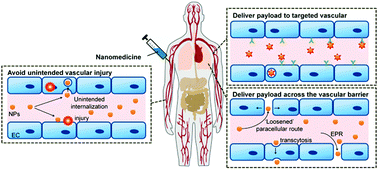Understanding and exploiting nanoparticles' intimacy with the blood vessel and blood
Abstract
While the blood vessel is seldom the target tissue, almost all nanomedicine will interact with blood vessels and blood at some point of time along its life cycle in the human body regardless of their intended destination. Despite its importance, many bionanotechnologists do not feature endothelial cells (ECs), the blood vessel cells, or consider blood effects in their studies. Including blood vessel cells in the study can greatly increase our understanding of the behavior of any given nanomedicine at the tissue of interest or to understand side effects that may occur in vivo. In this review, we will first describe the diversity of EC types found in the human body and their unique behaviors and possibly how these important differences can implicate nanomedicine behavior. Subsequently, we will discuss about the protein corona derived from blood with foci on the physiochemical aspects of nanoparticles (NPs) that dictate the protein corona characteristics. We would also discuss about how NPs characteristics can affect uptake by the endothelium. Subsequently, mechanisms of how NPs could cross the endothelium to access the tissue of interest. Throughout the paper, we will share some novel nanomedicine related ideas and insights that were derived from the understanding of the NPs' interaction with the ECs. This review will inspire more exciting nanotechnologies that had accounted for the complexities of the real human body.


 Please wait while we load your content...
Please wait while we load your content...